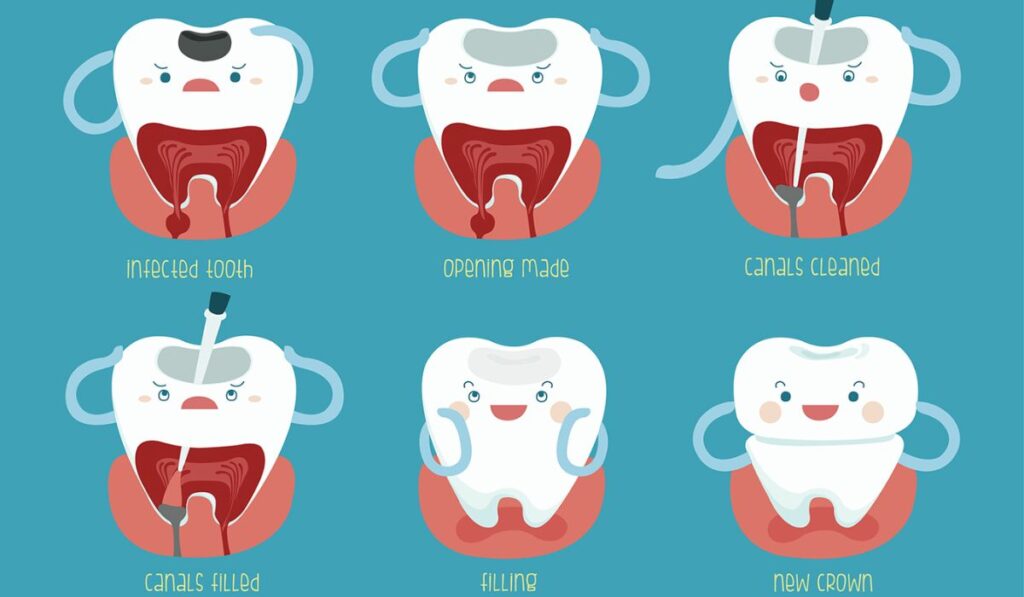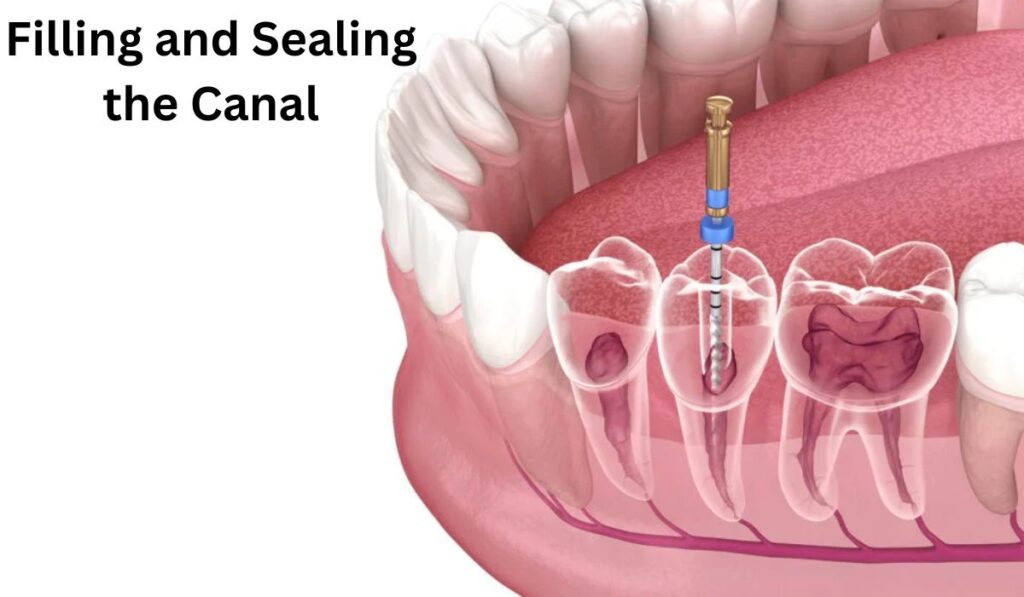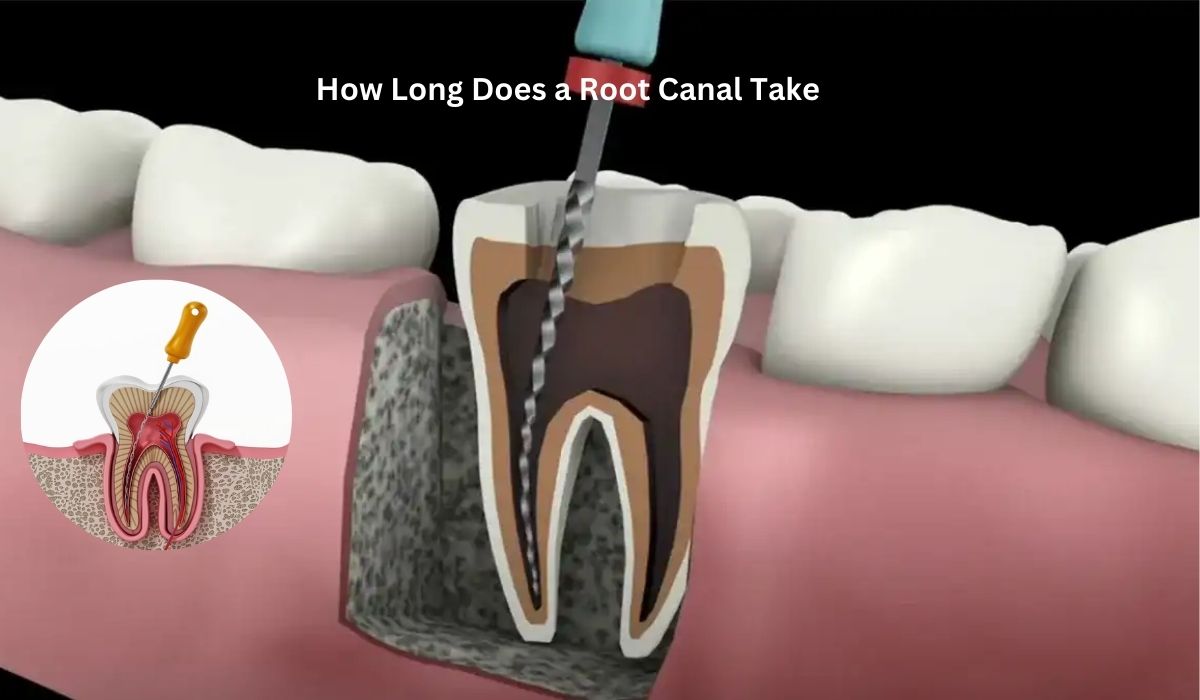Introduction to Root Canal Treatment
A root canal is a dental procedure that many of us might shudder to think about, but it’s often not as scary as it sounds. Imagine your tooth is like a little house with special rooms inside it called ‘pulp chambers’ where the nerves and blood vessels live. Sometimes, this part can get infected due to decay or injury, causing a lot of pain and discomfort. This is where a root canal comes in—it helps save the tooth by cleaning out these rooms, removing the bad stuff, and sealing it up to keep it safe.
Common Reasons for Needing a Root Canal
The main reason someone might need a root canal is because of pain from a deep cavity that has reached the nerve of the tooth. Other reasons include:
-
Infections: When bacteria find their way deep inside the tooth, they can cause infections that damage the pulp.
-
Dental injuries: A bad fall or a blow to the mouth can harm the teeth, leading to the need for a root canal.
-
Repeated dental work: Teeth that have had many fillings or other treatments might eventually need a root canal.
Typical Duration of a Root Canal Procedure
General Time Frame for Standard Root Canal Treatments
Typically, a root canal treatment can be completed in one to two visits to your dentist or endodontist (a dentist who specializes in treating the inside of the tooth). Each visit might last between 30 minutes to over an hour. However, don’t worry—most of this time is spent making sure everything is perfectly clean and sealed, and the actual work doesn’t hurt because your mouth will be numb.
Differences in Time Based on Tooth Type (Anterior vs. Posterior)
The time needed for a root canal can vary depending on the tooth. The teeth at the front of your mouth, called anterior teeth, usually have just one root. This makes the process faster, often taking less than an hour. The teeth at the back of your mouth, called posterior teeth or molars, might have two or three roots. This can make the procedure last longer, sometimes up to 90 minutes.
Personal Experience Story
Let me share a quick story from my own life that really highlights the importance of not ignoring tooth pain. A few years back, I had a toothache that I kept putting off. I thought it would just go away. Well, it didn’t. By the time I got to the dentist, I was in so much pain that I couldn’t eat on that side of my mouth. My dentist told me I needed a root canal. I was nervous, but honestly, the relief I felt afterward was incredible. It was like night and day. The procedure itself was pain-free—something I never expected! The anticipation was the worst part. After about an hour in the chair, I walked out feeling like a new person.
I learned it’s important to fix dental problems right away. I should not let fear stop me from taking care of my teeth. Plus, it showed me how skilled dentists are at making the process as comfortable as possible.
Learning about a root canal can help you feel ready and less worried. This common treatment helps stop tooth pain and saves your tooth. Then, you can keep smiling for a long time!
Stages of the Root Canal Procedure: What to Expect and How Long Each Step Takes
So, you’ve been told you need a root canal. I remember that sinking feeling myself the first time I heard it. It sounds intense, right? But knowing what each stage entails can help ease those nerves. Root canals are like deep cleanings for your tooth’s inner canals – it’s all about getting rid of any infected tissue and sealing things up to prevent future issues. Here’s a breakdown of what each step involves, along with some insights from my own experience.

Initial Consultation and X-rays
Before diving into the actual procedure, your dentist or endodontist (a root canal specialist) needs a clear view of the problem. This is where X-rays come in. They provide a detailed picture of your tooth’s structure and reveal any infection lurking around the root. The dentist uses these images to plan how best to treat the tooth, considering its shape, length, and number of canals (some teeth have multiple).
In my case, the X-rays were quick and painless. I remember feeling a bit anxious, but my dentist explained every detail, pointing out areas that looked “iffy.” It’s like a map, showing the dentist the lay of the land before they start any work. This step usually takes about 15 to 20 minutes.
Anesthesia and Tooth Preparation
Here’s where things start to feel real. You’ll get local anesthesia to numb the area around the affected tooth, ensuring you won’t feel pain during the procedure. I won’t lie – I was pretty nervous about the needle, but the numbing gel they apply first made it barely noticeable. Once numb, the dentist places a small protective sheet, or “dental dam,” around the tooth to keep it isolated and dry. This makes it easier to work on the tooth without interference.
This preparation process takes about 10 to 15 minutes, but it’s crucial for keeping the area sterile and manageable. My dentist said the dental dam is like setting up a mini-surgical area. This step is quick, but essential for ensuring you stay comfortable throughout the process.
Cleaning and Shaping the Root Canal
Once everything is prepped, the actual cleaning begins. Using small tools, the dentist carefully removes the infected pulp – a soft tissue inside your tooth that contains nerves and blood vessels. It sounds complicated, but it’s all done with precision. They’ll clear out all the canals within the tooth, ensuring no bacteria remain. Next, the dentist will shape the canals, which is important for placing the filling material later on.
In my experience, this step took about 30 to 60 minutes for a straightforward tooth. If your tooth has multiple canals, like a molar, it can take a bit longer. The dentist might use a microscope to make sure they’re cleaning every little nook and cranny. Honestly, by this point, I was relaxed – the numbing agent did its job well, and all I felt was a bit of pressure.
Filling and Sealing the Canal
Once the canals are thoroughly cleaned, it’s time to fill and seal them. The dentist uses a rubbery material called gutta-percha to fill each canal, which prevents bacteria from re-entering the cleaned area. They might add an adhesive cement to keep the material securely in place. This filling process ensures the canals stay sealed, protecting the tooth from future infection.
Filling and sealing took about 15 to 30 minutes in my case. It was a relatively quick step, but knowing that the tooth was now sealed and safe was a big relief. My dentist described it as “giving the tooth a second chance,” and that stuck with me.

Final Restoration (Crown Placement)
After a root canal, most teeth need a crown to protect them. Since the infection and treatment can weaken the tooth, a crown acts like a shield, restoring its strength and function. This part may not happen the same day – you might need a follow-up appointment. First, your dentist will take impressions to create a custom crown that fits perfectly over your tooth. Once it’s ready, they’ll place it during a short visit.
In my experience, getting the crown took around two weeks after the root canal, and the appointment itself was quick, maybe 20 to 30 minutes. The crown not only strengthened the tooth but also matched my natural teeth perfectly, making it hard to tell which tooth had the procedure!
Factors Influencing the Duration of a Root Canal
Complexity of the Tooth Structure (Number of Canals)
Not all teeth are created equal when it comes to root canals. Front teeth, for instance, usually have a single canal, making the procedure fairly straightforward and quicker—often taking between 30 to 60 minutes. Molars, on the other hand, come with three or even four canals, each of which needs thorough cleaning, shaping, and filling. This extra complexity adds more time to the procedure, stretching it to 90 minutes or even longer. Picture a simple bike repair versus tuning up a car engine—the extra work requires a steady hand and precision, which only adds to the time spent in the chair.
Severity of Infection and Inflammation
If the tooth is heavily infected or inflamed, this too can make the process longer. When bacteria deeply invade the tooth’s pulp, the dentist has to take extra care to clean every corner of the canal system to prevent future complications. This might require specialized tools and techniques, adding to the time. Think of it like cleaning a muddy floor versus a lightly dusty one—the messier it is, the longer it takes to scrub clean. In some cases, if the infection is too severe, the dentist might even need to delay part of the treatment and prescribe antibiotics to reduce inflammation before proceeding with the full root canal.
Skill and Technique of the Dentist or Endodontist
A root canal is a delicate and intricate procedure, and the experience of the dentist plays a significant role in the time it takes. Experienced endodontists, who specialize in root canals, often use advanced tools and techniques to speed up the process without sacrificing quality. They are also well-versed in handling complex cases efficiently. It’s like the difference between a beginner and a seasoned chef—they both might be following the same recipe, but the expert can move through each step more smoothly. For patients, seeking a specialist might mean a quicker and more comfortable experience.
One Visit vs. Multiple Visits
Situations That Can Be Handled in a Single Visit
Many root canals, especially simpler ones on front teeth or minimally infected teeth, can be completed in a single visit. If the tooth has only one canal and no major infection, the dentist can often clean, shape, and fill the canal in one sitting, saving patients the need for multiple trips. It’s like going to a one-stop shop where you get everything you need in one go—quick and efficient.
Reasons for Needing Multiple Appointments
In more complex cases, though, multiple visits might be necessary. For instance, a molar with multiple canals or a tooth with severe infection may require additional cleaning or medication in between visits to fully treat the infection. The first visit usually involves cleaning out the infected pulp and placing medication inside the tooth to reduce infection. In the following visit(s), the dentist will complete the cleaning, shaping, and sealing process. This staged approach gives the tooth time to heal and ensures that all infection is properly addressed, preventing future issues.
Recovery Time and What to Expect After a Root Canal
Typical Healing Times and Post-Procedure Care
After a root canal, most people feel mild pain or soreness. This lasts for a few days. You can usually manage it with pain relievers like ibuprofen. Most people feel normal again within a week. During this time, try not to chew on the treated side of your mouth. Stick to soft foods to help the tooth heal. It’s like nursing a sprained ankle—you need to rest it a bit to avoid any unnecessary strain.
Common Symptoms During Recovery and How to Manage Them
It’s normal to feel some tenderness in the treated area and even mild swelling or sensitivity to pressure. These symptoms usually fade within a few days. Place an ice pack on the outside of your cheek to help reduce swelling. Rinse your mouth with warm salt water to keep the area clean and soothe your gums. Just as you would with a sore muscle, gentle care and some TLC go a long way toward recovery.
Advanced Root Canal Procedures

Overview of More Complex Root Canal Treatments
For teeth with unusual anatomy or severe infection, advanced root canal techniques might be needed. Some teeth have extra or curved canals that require specialized tools and methods. Complex root canals may need special tools, like microscopes or digital imaging. These tools help the dentist see every detail. It might mean a longer visit or more than one appointment. But this careful work can lead to better results over time.
Expected Time Extensions for Complicated Cases
A simple root canal on a tooth with one canal usually takes 30 to 60 minutes. In harder cases, it may take two hours or even need more visits. Think of it as assembling a complex puzzle where each piece has to fit just right. The extra time and attention to detail are worth it for the health and stability of the tooth.
Tips for a Smooth Root Canal Procedure
How to Prepare for Your Appointment
To make the procedure as comfortable as possible, it’s a good idea to have a healthy meal beforehand, as your mouth will be numb for a few hours afterward. Avoid caffeine if possible, as it can make you feel jittery during the procedure. Wear comfortable clothing, and bring a pair of earphones if you want to listen to music or a podcast to help you relax in the chair.
Steps to Reduce Treatment Time and Enhance Recovery
Following the dentist’s instructions is crucial. Take any prescribed antibiotics to help clear the infection. Keep the area clean with good oral hygiene. Brush regularly and floss gently around the treated area. This will help prevent more problems. Avoid hard or sticky foods for a few days. This gives the treated tooth time to heal without extra pressure. Treat it as you would a delicate plant—give it the right care, and it’ll thrive.
FAQS
How Long Does a Root Canal Take?
A root canal can take anywhere from 30 minutes to about two hours. Simple cases, such as treating a front tooth with a single canal, usually wrap up in about 30 to 60 minutes. Molars, with multiple canals, may take up to 90 minutes or more. For complicated cases with infection or multiple visits, the total time can span several hours spread across multiple appointments.
Is a Root Canal Painful?
The thought of a root canal may cause anxiety, but modern root canal treatments are relatively painless. With the help of local anesthesia, most patients feel only mild pressure or a sensation similar to getting a filling. After the procedure, mild discomfort or soreness is common, but it typically fades in a few days and is manageable with over-the-counter pain relievers.
Can a Root Canal Be Completed in One Visit?
Yes, in many cases, especially for front teeth or teeth with minimal infection, a root canal can be completed in one visit. For teeth with multiple canals, deep infection, or other complexities, the dentist may recommend additional visits to ensure thorough cleaning and proper healing.
What Factors Influence the Duration of a Root Canal?
Several factors can impact how long a root canal takes, including the type of tooth being treated (front teeth vs. molars), the number of canals, the severity of infection, and the skill of the dentist or endodontist. A root canal on a molar, for example, generally takes longer due to the tooth’s larger size and the number of canals.
How Soon Can I Eat After a Root Canal?
Once the anesthesia wears off (usually within a few hours), you can eat, though it’s best to stick to soft foods for the first day. Avoid chewing on the treated tooth until any soreness has subsided and, ideally, until you get a permanent crown or filling to protect the tooth.
How Long Does It Take to Recover from a Root Canal?
Most people recover from a root canal within a week, though minor tenderness can last a few days. Full recovery involves any necessary follow-up treatments, like a crown placement, to fully restore the tooth’s function and strength.
For More More Visit: Creative Blogs


